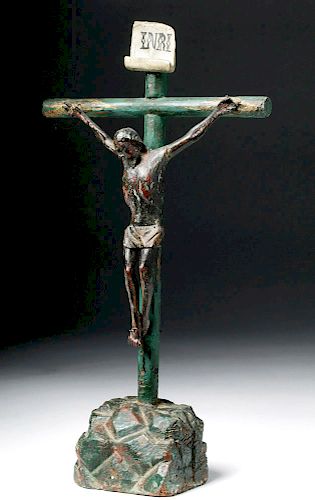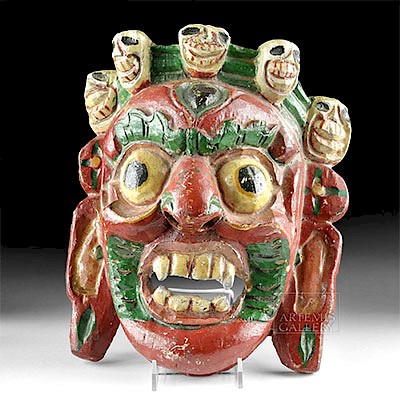19th C. Guatemalan Carved Wood Cristo Negro
Lot 204
About Seller
Artemis Gallery
686 S Taylor Ave, Ste 106
Louisville, CO 80027
United States
Selling antiquities, ancient and ethnographic art online since 1993, Artemis Gallery specializes in Classical Antiquities (Egyptian, Greek, Roman, Near Eastern), Asian, Pre-Columbian, African / Tribal / Oceanographic art. Our extensive inventory includes pottery, stone, metal, wood, glass and textil...Read more
Estimate:
$900 - $1,350
Absentee vs Live bid
Two ways to bid:
- Leave a max absentee bid and the platform will bid on your behalf up to your maximum bid during the live auction.
- Bid live during the auction and your bids will be submitted real-time to the auctioneer.
Bid Increments
| Price | Bid Increment |
|---|---|
| $0 | $25 |
| $300 | $50 |
| $1,000 | $100 |
| $2,000 | $250 |
| $5,000 | $500 |
| $10,000 | $1,000 |
| $20,000 | $2,500 |
| $50,000 | $5,000 |
| $100,000 | $10,000 |
| $200,000 | $20,000 |
About Auction
By Artemis Gallery
Apr 25, 2019
Set Reminder
2019-04-25 10:00:00
2019-04-25 10:00:00
America/New_York
Bidsquare
Bidsquare : Pre-Columbian | Tribal | Ethnographic
https://www.bidsquare.com/auctions/artemis-gallery/pre-columbian-tribal-ethnographic-4035
Featuring ancient and ethnographic art from around the world, including Pre-Columbian, Native American, African / Tribal, Ethnographic, Spanish Colonial, Fossils, Fine Art, much more. Artemis Gallery info@artemisgallery.com
Featuring ancient and ethnographic art from around the world, including Pre-Columbian, Native American, African / Tribal, Ethnographic, Spanish Colonial, Fossils, Fine Art, much more. Artemis Gallery info@artemisgallery.com
- Lot Description
Latin America, Guatemala, ca. 19th century CE. A hand carved and painted depiction of the Cristo Negro (Black Christ) on the cross with the letters "INRI" (Latin for Jesus of Nazareth, the King of the Jews) on a white banner above (the banner said to have been placed there by Pontius Pilate), upon the little mountain or hill of Golgotha. The worship of Cristo Negro has its origins in a town called Esquipulas, Guatemala in 1594 CE when an image was created by the Portuguese sculptor Quirio Cantano upon the request of the Guatemalan bishop. The darker complexion chosen by the early clergy was intentional, as it was thought that the indigenous population would then identify with the sufferings and sacrifice of Christ. As members of the lowest class of their society in their own land, they embraced the Cristo Negro and identified with his realistic agony and martyrdom. Size: 12.25" H (31.1 cm)
The dark brown of many Christ figures naturally darkened further to a blacker hue due to exposure to smoke and incense. And so, although the initial brown was intended to represent Indian skin color, many Christs created by the native population were created in the color black. In time miracles were ascribed to the so-called Black Christ or Cristo Negro. This example is characteristically depicted in the crucified pose, with head cocked toward the right, blue mantle tied around waist and hips, and perforations indicative of stigmata through extended hands and feet and one laceration at chest. A wondrous work of Spanish Colonial religious art!
Provenance: private Moore collection, Denver, Colorado, USA, acquired thirty years ago
All items legal to buy/sell under U.S. Statute covering cultural patrimony Code 2600, CHAPTER 14, and are guaranteed to be as described or your money back.
A Certificate of Authenticity will accompany all winning bids.
We ship worldwide and handle all shipping in-house for your convenience.
#121997A few fingers/fingertips missing. Expected surface wear with pigment losses as shown, though much pigment remains.Condition
- Shipping Info
-
All shipping is handled in-house for your convenience. Your invoice from Artemis Gallery will include shipping calculation instructions. If in doubt, please inquire BEFORE bidding for estimated shipping costs for individual items.
-
- Buyer's Premium



 EUR
EUR CAD
CAD AUD
AUD GBP
GBP MXN
MXN HKD
HKD CNY
CNY MYR
MYR SEK
SEK SGD
SGD CHF
CHF THB
THB

















